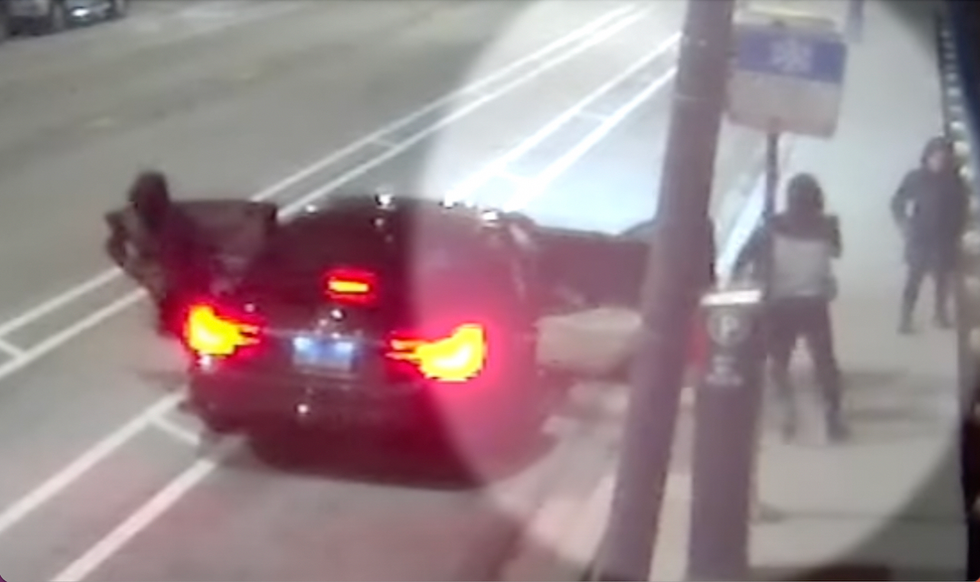
www.theblaze.com
Blaze News original: 10 times bystanders failed to help victims of brutal violence — and often recorded video instead
Like many public transit systems, BART — northern California's Bay Area Rapid Transit System — often is a magnet for crime.On March 28, KRON-TV reported that the number of passengers arrested for felonies on BART trains and in BART stations doubled in 2023; indeed ridership numbers fell that year and in 2022, and the top reason among riders was feeling unsafe.'A lot of people wouldn’t help him because they were scared, too.'The very next day — March 29 — BART touted what can be described as an only-in-northern-California program on its X account to encourage riders to get involved in fighting back against crime on trains and buses. The use of "bystander intervention cards." Check it out:
— (@)
Yup, things have actually gotten to the point that cards are being employed to help bystanders feel more permitted to intervene when a crime is being committed.A couple of young women helped BART tout the bystander intervention cards. One noted that they "give me a concrete way to deal with an unsafe situation. I'm not very equipped to deal with them on my own, and so these cards give me a sense of community and a sense of support." The other said the cards are "a really easy way to either help someone or to ask for help without having to do much."
— (@)
But in many cases, that's the world we live in. Bystanders and witnesses to crime often don't feel safe or equipped to help crime victims. And why is that? If you put yourself in their shoes, the likely reasons become quite apparent. Intervening bystanders may wind up getting hurt, too, or even find themselves on the wrong end of lawsuit brought by the perps.Of course, if things go really wrong — as they did with Marine veteran Daniel Penny who last year subdued an erratic New York City subway passenger who died as a result — you can wind up becoming the target of left-wing district attorneys.What's not very understandable is when the only action bystanders take is pulling out their cellphones and recording the crimes happening right in front of them. It could be argued that such video can serve as valuable evidence, but often the videographers are just looking for hits or likes on their social media accounts.The following are 10 times when bystanders failed to help victims of brutal violence — and in most of these cases recorded video instead:Train riders point their phones toward female passenger who's attacked and raped, but none of the riders intervene — or even call 911, police sayThe horrific incident took place on the night of Oct. 13, 2021, in Upper Darby, Pennsylvania, which is a Philadelphia suburb. Thomas Nestel, police chief of the Southeastern Pennsylvania Transportation Authority told KYW-TV, "There were people witnessing the act with phones in their hands," and "people were holding their phone[s] up in the direction of this woman being attacked." But despite all the apparent phone usage, none of the passengers called 911, Nestel said, according to the station. Finally, an off-duty SEPTA employee who witnessed the assault called an emergency line, and then SEPTA police entered the train, pulled the suspect off the victim, and arrested him, the Philadelphia Inquirer reported. Fiston Ngoy told police he recognized the woman, approached her to start a conversation, and that their encounter was consensual, the paper added, citing the affidavit of probable cause for his arrest. The woman told police Ngoy's claims are false, the Inquirer said, adding that investigators said surveillance video corroborates the victim's claim that Ngoy made unwanted advances. She also said she recalled boarding the train but didn't recall anything afterward until officers pulled Ngoy off her."There was a lot of people, in my opinion, that should have intervened. Somebody should have done something," Upper Darby Police Superintendent Timothy Bernhardt said, according to the paper. "It speaks to where we are in society and who would allow something like that to take place. So it's troubling."Ngoy pleaded guilty to rape of an unconscious person, a first-degree felony; last April, he was sentenced to seven to 14 years in state prison, the Delaware County Times reported.Tearful mother says female panhandler repeatedly punched her 2-year-old boy in face on subway train — but fellow riders wouldn't interveneThe shocking incident unfolded on a Saturday in February 2021 on the northbound C train at Frederick Douglass Boulevard and West 116th Street in Manhattan. The 21-year-old mother of two children spoke to WCBS-TV on camera but did so without showing her face. She tearfully told the station that her 2-year-old boy was sleeping on her lap when the panhandler began asking passengers for money. When the panhandler got too close to the woman and her toddler, the boy's mother asked her to keep social distancing guidelines. The panhandler got angry, stepped on the mom's foot, and began to swing her fists and punch the small boy in his face."And I was just asking people like, 'Yo, can y'all please get my baby, please get him, like, and nobody tried to stop, like, she was standing there!" the woman told WCBS while shedding tears. She told the New York Post that none of the passengers helped her. The child was taken to a hospital for his injuries and released. His mother told WCBS a doctor told her that her child might experience seizures as a result of his injuries.Days later, police arrested 56-year-old Elizabeth Galarza in connection with the incident and charged her with assault and acting in a manner injurious to a child.Girl beaten up in middle school hallway allegedly by male who identifies as female; several cellphone cameras are out — and no one helpsThe video in question was recorded last September at Hazelbrook Middle School in Tualatin, a suburb of Portland. The attacker grabbed a girl from behind and yanked her backward so hard that she quickly fell to the hallway floor. The attacker then grabbed the victim's hair with both hands and pulled and pushed her head from side to side. Finally, the attacker stood above the cowering victim and repeatedly pounded her shoulder before cursing at her and delivering a parting blow to the victim's head. No one helped. The video ended with the tearful victim slowly getting up and saying she can't breathe.OregonLive reported that officials in the Tigard-Tualatin School District said at the time that the attack is under criminal investigation. The attacker was arrested and is facing assault charges, the outlet added, citing Jennifer Massey, public information officer for the Tualatin Police Department.A reaction was posted to social media allegedly by the victim's mother: "Yesterday my daughter was attacked at school by a biological male student dressed as a girl. I cannot even put into words my anger at the situation after watching his horrific video nor my distraught [sic] knowing I can't do anything because I will ultimately end up in jail." The post added that "assaulting someone is never ok BUT a boy/man should NEVER lay hands on a girl/woman, and that's on the parents for not raising a decent human being."Police surveillance video: Armed crooks threaten, rob woman — then return to physically attack her after passing motorists ignore her pleas for helpPolice surveillance video recorded the terrifying moment a mob threatened and robbed a woman walking on a Chicago street after midnight Jan. 31 — and then came back to attack her again after several passing motorists ignored her pleas for help. The 35-year-old victim was walking on Lawrence Avenue in Jefferson Park on her way to work when a car pulled up and four men jumped out and surrounded her. The victim told WLS-TV they had guns and threatened her while taking her property, including her cellphone and wallet. The video shows the mob getting back into their car and speeding away. The woman tried to flag down motorists, including the driver of a Chicago Transit bus, but no one stopped. With that, the attackers came back, and video shows one assailant appear to punch her. "They told her they were going to shoot her if she didn't give them [a card] pin," the victim's daughter told WLS. "The next time they came, she thought they were going to kill her for the same thing." The victim was hospitalized and reported in good condition, the station said, adding the police named no suspects.Students beaten, pistol-whipped outside high school as bystanders record attacks on video and laughThe pair of brutal attacks took place outside Susan Wagner High School on Staten Island on Dec. 6, 2021, as students waited for buses after school. Witnesses said two young males jumped out of a parked vehicle and began attacking two male students. A 16-year-old victim couldn't fend off his attacker, and the New York Post said a suspect pulled out what appeared to be a gun to pistol-whip the teen while the victim was on the ground. The second beatdown took place next to the aforementioned attack, and video — which you can view here — showed a suspect stomping a student while the student was cowering on the ground in an attempt to escape the blows, which prompted bystanders to break out into laughter. At one point, a bystander was heard saying, "He's dead, bro, he's [a] dead body." A spokesperson for the department of education said the attackers weren't students. Emergency responders took the 16-year-old to a hospital where he was treated for a deep head cut and bruises. Authorities at the time didn't arrest any suspects in connection with the attacks.Female HS student brutally beats another female in class with more than 30 punches to her head; it's all captured on cellphone video while other students giggle — and no one puts stop to itClark County School District Police on Feb. 2, 2022, were called to Las Vegas High School over a physical altercation that left one female student injured, Lt. Bryan Zink told the Las Vegas Sun. The attack was captured on video, which you can view here. The clip shows the attacker charging at the victim — who's sitting at a desk — from the rear of the classroom and repeatedly punching her in the head. A decidedly meek voice — perhaps from a teacher — implores the attacker to “stop, stop, stop” and "get off of her" as a pair of hands vainly attempts to prevent more punches from being thrown. But the person who attempts to intervene soon gives up as several students are heard giggling in the background. At this point the victim — who initially had both hands trying to protect the back of her head — slumps down on the desk as her left hand goes limp. But the attacker wasn't through. The attacker switches to her right fist and continues pounding the victim's head as audible thuds are heard, presumably from the impact of her skull banging against the desk's surface. After approximately 36 punches to the victim's head and one weak attempt at stopping the assault, the attacker walks away as the victim stays motionless. According to KTNV-TV, it wasn't clear what injuries the victim suffered or what condition she was in. The Sun said the female student shown instigating the fight was cited for battery.HS student's head forced into boy's restroom toilet as observers laugh and fail to intervene. Then video of attack is posted online.Video posted online — which you can view here — shows students at Wilmington (Mass.) High School carrying and dragging another student through a boys' restroom and forcing the victim's head into a toilet, WBZ-TV reported. The incident occurred March 29, 2022; officials told the station no one intervened.“As a parent, let alone an educator, I am appalled that some of our students decided to act the way that they did," Glenn Brand, superintendent of Wilmington Public Schools, told WBZ in a statement. "But what is equally disturbing is the fact that other students were present and did nothing to stop the incident, and in fact recorded the altercation. I assure you that all students who are found culpable will be held fully accountable and appropriate disciplinary and legal action will be taken.”Wilmington Police Chief Joseph Desmond told WFTX-TV police have at least three video recordings and are working with the school to identify everyone involved: “It clearly looks like an assault as far as where I come from."Students brutally beat teen as others applaud, record the attack on videoA 17-year-old boy was so severely beaten in a July 2021 attack his broken jaw punctured his skin and tore the inside of his mouth. The attack took place during a basketball game at a Sugar Hill, Georgia, recreation center. As the group savaged Nick Cox in what his parents said was an unprovoked attack, bystanders laughed, cheered, and recorded video — which you can view here. The victim's mother, Alyssa Brooke-Cox, spent her son's birthday feeding him liquids through a syringe, WAGA-TV reported."People actually applauded," his mother said. "I don't understand that. I can't even now understand it. I don't know where the disconnect is with seeing someone get hurt and finding joy and humor. I can't fathom that and it haunts me."Nick may need further reconstructive surgeries down the road and was devastated when he learned his attackers "are still going about their everyday activities.""When he found out that the kids who did this to him were still able to go to school and play sports and live life as normal, that hit him pretty hard because his entire life has completely changed," his father added.Multiple attackers brutally beat up 14-year-old boy at theme park over $1,400 shoes while bystanders do nothing but record videoWSB-TV's story about the vicious beating ran last June, but the date of the attack is unclear. The harrowing incident took place at the Six Flags over Georgia theme park. The victim didn't want to be identified because his alleged assailants have not been arrested: “I don’t know why they [were] following me. I didn’t do nothing wrong. I’m just minding my business." He said his mother dropped him off at the theme park for his cousin's birthday party after which a group of strangers followed and harassed him over his expensive Balenciaga shoes.“They were asking me if I rep any gang or anything, and I was like, ‘No, I don’t rep no gang. I’m just trying to get to my people for a birthday party,’” he explained to WSB, adding that he tried to defend himself but was outnumbered and ended up on the ground where his alleged assailants kicked and punched him in the head until he was unconscious. “We were at the hospital for about 10 hours," his mother told WSB. "They had to do two cat scans on his head — his body."Boy mugged at gunpoint in broad daylight while 4 people record cellphone video, and others just stand thereThe incident took place on a Saturday evening in early June 2022 at the Brooklyn Bridge Park Pier 2 in New York City. Video showed a group surrounding the boy who was pushed against a large boulder and punched; a gun also was put to his head. Bystanders apparently did nothing except record video. Police said the group stole a debit card, a cellphone, a hat, identification cards, and even the teen's sneakers. The victim refused medical attention, and officials said he knew some of the people who attacked and robbed him.But the victim's mother told the New York Post her straight-A student son didn't know any of his attackers. “I was shocked,” Alasha Guy, 33, told the Post of the attack. “He called me after it happened and he was still shaking and distraught. A lot of people wouldn’t help him because they were scared, too." She added to the paper "that was [his] first time being out on his own with some of his friends. That was the first time I let him out on his own and then this happens. He’s really a homebody."Like Blaze News? Bypass the censors, sign up for our newsletters, and get stories like this direct to your inbox. Sign up here!
















